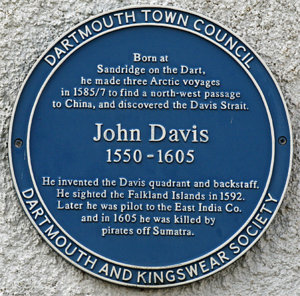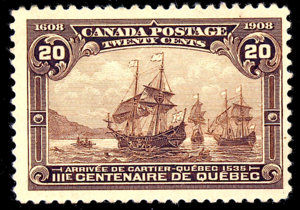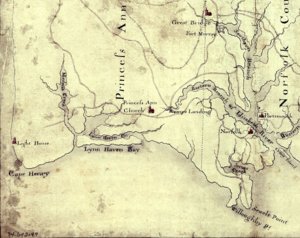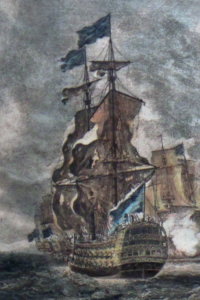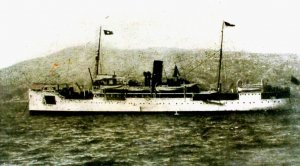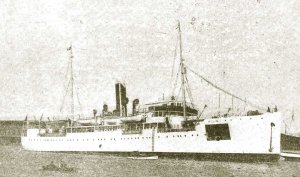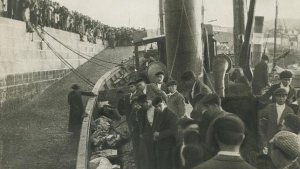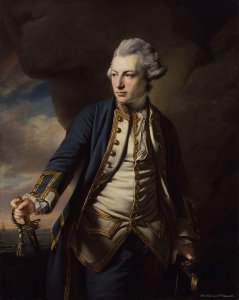Today in Naval History - Naval / Maritime Events in History
19th of December
some of the events you will find here,
please use the following link where you will find more details and all other events of this day .....
1606 – The ships Susan Constant, Godspeed, and Discovery depart England carrying settlers who founded, at Jamestown, Virginia, the first of the thirteen colonies that became the United States.
Late in 1606, English colonizers set sail with a charter from the London Company to establish a colony in the New World. The fleet consisted of the ships Susan Constant, Discovery, and Godspeed, all under the leadership of Captain Christopher Newport. They made a particularly long voyage of four months, including a stop in the Canary Islands and subsequently Puerto Rico, and finally departed for the American mainland on April 10, 1607. The expedition made landfall on April 26, 1607 at a place which they named Cape Henry. Under orders to select a more secure location, they set about exploring what is now Hampton Roads and an outlet to the Chesapeake Bay which they named the James River in honor of King James I of England. Captain Edward Maria Wingfield was elected president of the governing council on April 25, 1607. On May 14, he selected a piece of land on a large peninsula some 40 miles (64 km) inland from the Atlantic Ocean as a prime location for a fortified settlement. The river channel was a defensible strategic point due to a curve in the river, and it was close to the land, making it navigable and offering enough land for piers or wharves to be built in the future. Perhaps the most favorable fact about the location was that it was not inhabited by nearby Virginia Indian tribes, who regarded the site as too poor and remote for agriculture. The island was swampy and isolated, and it offered limited space, was plagued by mosquitoes, and afforded only brackish tidal river water unsuitable for drinking.

1739 – Launch of French Terrible, a 74 gun ship of the line, at Toulon,
Terrible was originally a 74-gun ship of the line of the French Navy launched in 1739. Captured on 14 October 1747, she was taken into Royal Navy service as the third rate HMS Terrible.

1744 – Launch of french Renommée, a 30-gun Sirène class frigate at Brest
La Renommée was one of the first 8-pounder armed frigates (frégates du deuxième ordre)
– captured by British Navy 27 September 1747 by HMS Dover , becoming HMS Renown and broken up in 1771.

There is a wonderfull planset of the Renommee by Jean Boudriot from ancre available. See our Planset Review:
https://www.shipsofscale.com/sosforums/index.php?threads/planset-review-la-renommÉe-frégate-de-viii-1744-1-48-jean-boudriot.2696/
A wonderful model in scale 1:48, I was able to see in Rochefort, was the model built by Dominique MAGNEN, a friend of Patrick

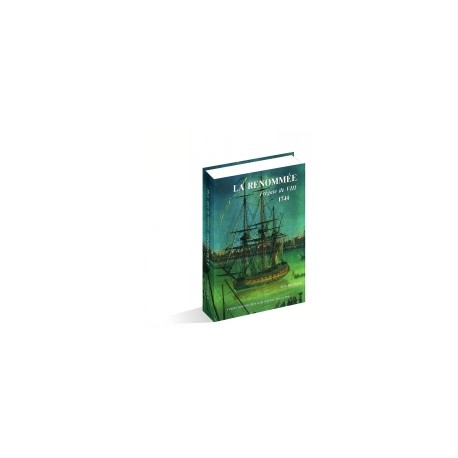

ancre.fr
1778 - French frigate Iphigénie (32) captured sloop HMS Ceres (18), Cdr. James Richard Dacres, off St. Lucia
named Cérès by french but in 1782 recaptured and renamed HMS Raven, in 1783 once more captured by french and named Cérès
HMS Ceres was an 18-gun sloop launched in 1777 for the British Royal Navy that the French captured in December 1778 off Saint Lucia. The French Navy took her into service as Cérès. The British recaptured her in 1782 and renamed her HMS Raven, only to have the French recapture her again early in 1783. The French returned her name to Cérès, and she then served in the French Navy until sold at Brest in 1791.

1782 – Launch of HMS Diadem, a 64-gun Intrepid-class third rate ship of the line
HMS Diadem was a 64-gun third rate ship of the line of the Royal Navy, launched on 19 December 1782 at Chatham. She participated in the Battle of Cape St Vincent in 1797 under Captain George Henry Towry.


1793 – Launch of french Seine, lead ship of the 42-gun Seine-class frigates
Seine was a 38-gun French Seine-class frigate that the Royal Navy captured in 1798 and commissioned as the fifth rate HMS Seine. On 20 August 1800, Seine captured the French ship Vengeance in a single ship action that would win for her crew the Naval General Service Medal. Seine's career ended in 1803 when she hit a sandbank near the Texel.

1793 – Launch of HMS Pallas, lead ship of the Pallas class frigates
The second HMS Pallas (1793) was a 32-gun fifth rate launched at Woolwich Dockyard in 1793 and wrecked in 1798 on Mount Batten Point, near Plymouth.

1796 – French Revolutionary Wars: Two British frigates under Commodore Horatio Nelson and two Spanish frigates under Commodore Don Jacobo Stuart engage in battle off the coast of Murcia.
Action of 19 December 1796 - HMS Minerve (38), Cptn. George Cockburn, Commodore Horatio Nelson, captured Spanish frigate Santa Sabina (40), Cptn. Don Jacob Steuart, and HMS Blanche (32) engaged Ceres which struck but could not be secured. An approaching Spanish squadron drove them off and the prize was retaken.

1912 – William Van Schaick, captain of the steamship General Slocum which caught fire and killed over one thousand people, is pardoned by U.S. President William Howard Taft after three-and-a-half-years in Sing Sing prison.
The PS General Slocum was a sidewheel passenger steamboat built in Brooklyn, New York, in 1891. During her service history, she was involved in a number of mishaps, including multiple groundings and collisions.
1941 – HMS Neptune sunk by mines off Tripoli, 736 of the crew perished, only one survived
HMS Neptune was a Leander-class light cruiser which served with the Royal Navy during World War II.
Neptune was the fourth ship of its class and was the ninth Royal Navy vessel to carry the name. Built by Portsmouth Dockyard, the vessel was laid down on 24 September 1931, launched on 31 January 1933, and commissioned into the Royal Navy on 12 February 1934 with the pennant number "20".

1944 - USS Redfish (SS 395) sinks the Japanese carrier Unryu - 200 nautical miles southeast of Shanghai, China. In the course of this engagement, Redfish is damaged and terminates her patrol early - Casualties were very heavy with 1,238 officers, crewmen and passengers losing their lives. Only 145 men survived.
The Japanese aircraft carrier Unryū (雲龍 Cloud Dragon) was the lead ship of her class of fleet aircraft carriers built for the Imperial Japanese Navy (IJN) during World War II. She was commissioned in mid-1944, but fuel and aircrew shortages limited her use to Japanese waters. The impending American invasion of Luzon caused the IJN to order her to transport aircraft and supplies to the Philippines in December. The ship was torpedoed and sunk by the American submarine USS Redfish in the East China Sea during the voyage.

19th of December
some of the events you will find here,
please use the following link where you will find more details and all other events of this day .....
Naval/Maritime History - 18th of April - Today in Naval History - Naval / Maritime Events in History
Today in Naval History - Naval / Maritime Events in History 18 December 1779 - Combat de la Martinique French squadron of 3 ships of the line, escorting a 26 ship convoy engaged English squadron of 13 ships of the line and a frigate, blockading Fort Royal, Martinique.10 of the merchant ships...
shipsofscale.com
1606 – The ships Susan Constant, Godspeed, and Discovery depart England carrying settlers who founded, at Jamestown, Virginia, the first of the thirteen colonies that became the United States.
Late in 1606, English colonizers set sail with a charter from the London Company to establish a colony in the New World. The fleet consisted of the ships Susan Constant, Discovery, and Godspeed, all under the leadership of Captain Christopher Newport. They made a particularly long voyage of four months, including a stop in the Canary Islands and subsequently Puerto Rico, and finally departed for the American mainland on April 10, 1607. The expedition made landfall on April 26, 1607 at a place which they named Cape Henry. Under orders to select a more secure location, they set about exploring what is now Hampton Roads and an outlet to the Chesapeake Bay which they named the James River in honor of King James I of England. Captain Edward Maria Wingfield was elected president of the governing council on April 25, 1607. On May 14, he selected a piece of land on a large peninsula some 40 miles (64 km) inland from the Atlantic Ocean as a prime location for a fortified settlement. The river channel was a defensible strategic point due to a curve in the river, and it was close to the land, making it navigable and offering enough land for piers or wharves to be built in the future. Perhaps the most favorable fact about the location was that it was not inhabited by nearby Virginia Indian tribes, who regarded the site as too poor and remote for agriculture. The island was swampy and isolated, and it offered limited space, was plagued by mosquitoes, and afforded only brackish tidal river water unsuitable for drinking.
1739 – Launch of French Terrible, a 74 gun ship of the line, at Toulon,
Terrible was originally a 74-gun ship of the line of the French Navy launched in 1739. Captured on 14 October 1747, she was taken into Royal Navy service as the third rate HMS Terrible.
1744 – Launch of french Renommée, a 30-gun Sirène class frigate at Brest
La Renommée was one of the first 8-pounder armed frigates (frégates du deuxième ordre)
– captured by British Navy 27 September 1747 by HMS Dover , becoming HMS Renown and broken up in 1771.
There is a wonderfull planset of the Renommee by Jean Boudriot from ancre available. See our Planset Review:
https://www.shipsofscale.com/sosforums/index.php?threads/planset-review-la-renommÉe-frégate-de-viii-1744-1-48-jean-boudriot.2696/
A wonderful model in scale 1:48, I was able to see in Rochefort, was the model built by Dominique MAGNEN, a friend of Patrick

MONOGRAPHIE DE LA RENOMMEE - Frégate de 8 - 1744 - Ancre
8-pdr Frigate LA RENOMMÉE 1744 A monograph with all the timbers construction. New: In addition the 31 Plans at 1 / 36th without Sails - AVAILABLE canopy.ancre.fr
1778 - French frigate Iphigénie (32) captured sloop HMS Ceres (18), Cdr. James Richard Dacres, off St. Lucia
named Cérès by french but in 1782 recaptured and renamed HMS Raven, in 1783 once more captured by french and named Cérès
HMS Ceres was an 18-gun sloop launched in 1777 for the British Royal Navy that the French captured in December 1778 off Saint Lucia. The French Navy took her into service as Cérès. The British recaptured her in 1782 and renamed her HMS Raven, only to have the French recapture her again early in 1783. The French returned her name to Cérès, and she then served in the French Navy until sold at Brest in 1791.
1782 – Launch of HMS Diadem, a 64-gun Intrepid-class third rate ship of the line
HMS Diadem was a 64-gun third rate ship of the line of the Royal Navy, launched on 19 December 1782 at Chatham. She participated in the Battle of Cape St Vincent in 1797 under Captain George Henry Towry.
1793 – Launch of french Seine, lead ship of the 42-gun Seine-class frigates
Seine was a 38-gun French Seine-class frigate that the Royal Navy captured in 1798 and commissioned as the fifth rate HMS Seine. On 20 August 1800, Seine captured the French ship Vengeance in a single ship action that would win for her crew the Naval General Service Medal. Seine's career ended in 1803 when she hit a sandbank near the Texel.
1793 – Launch of HMS Pallas, lead ship of the Pallas class frigates
The second HMS Pallas (1793) was a 32-gun fifth rate launched at Woolwich Dockyard in 1793 and wrecked in 1798 on Mount Batten Point, near Plymouth.
1796 – French Revolutionary Wars: Two British frigates under Commodore Horatio Nelson and two Spanish frigates under Commodore Don Jacobo Stuart engage in battle off the coast of Murcia.
Action of 19 December 1796 - HMS Minerve (38), Cptn. George Cockburn, Commodore Horatio Nelson, captured Spanish frigate Santa Sabina (40), Cptn. Don Jacob Steuart, and HMS Blanche (32) engaged Ceres which struck but could not be secured. An approaching Spanish squadron drove them off and the prize was retaken.
1912 – William Van Schaick, captain of the steamship General Slocum which caught fire and killed over one thousand people, is pardoned by U.S. President William Howard Taft after three-and-a-half-years in Sing Sing prison.
The PS General Slocum was a sidewheel passenger steamboat built in Brooklyn, New York, in 1891. During her service history, she was involved in a number of mishaps, including multiple groundings and collisions.
1941 – HMS Neptune sunk by mines off Tripoli, 736 of the crew perished, only one survived
HMS Neptune was a Leander-class light cruiser which served with the Royal Navy during World War II.
Neptune was the fourth ship of its class and was the ninth Royal Navy vessel to carry the name. Built by Portsmouth Dockyard, the vessel was laid down on 24 September 1931, launched on 31 January 1933, and commissioned into the Royal Navy on 12 February 1934 with the pennant number "20".
1944 - USS Redfish (SS 395) sinks the Japanese carrier Unryu - 200 nautical miles southeast of Shanghai, China. In the course of this engagement, Redfish is damaged and terminates her patrol early - Casualties were very heavy with 1,238 officers, crewmen and passengers losing their lives. Only 145 men survived.
The Japanese aircraft carrier Unryū (雲龍 Cloud Dragon) was the lead ship of her class of fleet aircraft carriers built for the Imperial Japanese Navy (IJN) during World War II. She was commissioned in mid-1944, but fuel and aircrew shortages limited her use to Japanese waters. The impending American invasion of Luzon caused the IJN to order her to transport aircraft and supplies to the Philippines in December. The ship was torpedoed and sunk by the American submarine USS Redfish in the East China Sea during the voyage.



